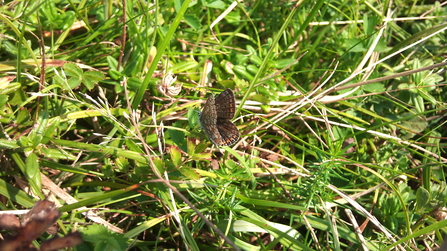Biodiversity Net Gain (BNG) is an approach to new development that aims to leave nature in a measurably better state than it was found.
Wildlife Trusts across England, including Avon Wildlife Trust, are working with developers on their BNG strategies or providing off-site habitat compensation. Our approach to BNG is characterised by seeking the best, additional gains for nature, participation of local communities, and desirable developments to live and work.
'Gold standard' Biodiversity Net Gain
If done well, BNG offers a positive step forward in the way we think about development and nature in a more integrated way. That’s why we strive to deliver a ‘gold standard’ of BNG that ensures real long term gains for nature, as well as desirable developments that are home to happy and healthy communities that are connected to nature.

-
We will aspire to go beyond the minimum 10% and strive to deliver at least 20% Biodiversity Net Gain in our habitat banks.
-
We will focus our BNG on Local Nature Recovery Strategies as part of a bigger picture of nature’s recovery.
Biodiversity Net Gain explianer (https://www.youtube.com/watch?v=_muGlfXSrYs)
(c) The Wildlife Trusts
Biodiversity Net Gain explained
What is Biodiversity Net Gain?
Biodiversity Net Gain (BNG) is a land management approach designed to achieve measurable improvements for nature by creating or enhancing habitats such as wildlife areas, rivers, streams, and hedgerows, often in connection with new developments. These biodiversity improvements must be "additional," meaning that new projects should leave nature in a better condition than before.
The Wildlife Trusts have played a key role in shaping BNG for over a decade, starting from early efforts in 2012 to measure and offset biodiversity loss due to development. They have been instrumental in testing and refining the Defra metric and advocating for strong BNG commitments in legislation. At a local level, Wildlife Trusts have influenced the inclusion of BNG policies in local plans and promoted voluntary adoption of BNG. Recently, many Wildlife Trusts have also positioned themselves as providers of high-quality habitats to support BNG initiatives.
Why is Avon Wildlife Trust engaging in BNG?
If done well, BNG offers a positive step forward in the way we think about development and nature in a more integrated way. It also offers new ways to fund and implement nature’s recovery, raising money from the sales of biodiversity units to reinvest in nature’s recovery and making sure biodiversity is at the heart of the planning process.
What BNG services does Avon Wildlife Trust offer?
Avon Wildlife Trust is currently exploring the feasibility of providing high integrity environmental credits to the local nature market. We will update this page as our work progresses. If you have questions, please contact us using the form at the foot of the page.
Does Biodiversity Net Gain have to be delivered on the site of a new development?
There are three ways in which BNG can be delivered:
-
Firstly, through on-site enhancement and restoration of biodiversity (within the red line boundary of a development site).
-
Secondly, if all of the BNG cannot be delivered on site , off-site biodiversity gains can be considered. This can either be on land owned by the developer, outside of the development site, or through buying off-site biodiversity units.
-
Finally, if developers cannot achieve on-site or off-site BNG, they must buy statutory biodiversity credits from the government. This should be considered a last resort.
All three methods can be used, however they must be considered in order
All habitats created for BNG must be managed and monitored for 30 years to achieve and demonstrate the planned uplift. When delivering BNG on-site developers must carefully consider how the BNG gains can be managed, monitored and protected (e.g. ensuring these areas will not be needed for future development) over the 30 years. When considering on-site gains it is also very important to consider how additional on-site pressures, for example from increased footfall, dog walkers and other human usage, can be balanced and accounted for within the planned uplift.
What are the legal requirements for offsite Biodiversity Net Gain?
The delivery of off-site Biodiversity Net-Gain must be secured with a comprehensive Habitat Management and Monitoring Plan (HMMP) and legal agreement. The legal agreement can either be in the form of a Section 106 (S106) with the Local Planning Authority or through a Conservation Covenant with a Responsible Body. Once the HMMP and legal agreement are in place, the off-site BNG must then be registered on Natural England’s BNG register, that opened in February 2024. Once the site is registered BNG units can be sold and included within planning permissions.

